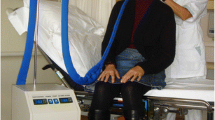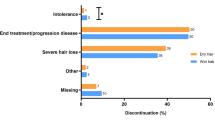Abstract
Purpose
Chemotherapy-induced alopecia is very distressing for a patient and may have an impact on treatment decisions. On docetaxel-based therapy, alopecia occurs in a substantial proportion of patients. We aimed to investigate whether two different methods of scalp cooling can prevent hair loss.
Methods
In this open-label, prospective, nonrandomized trial, patients with solid tumors receiving docetaxel in a palliative setting were allocated according to patients’ preference to short-term cooling (over 45 min postinfusion) with a Paxman® PSC-2 machine (PAX), with cold cap (CC), or no cooling. The combined endpoint was alopecia World Health Organisation (WHO) III or IV or the necessity to wear a wig. Study identifier is Clinicaltrials.gov NCT01008774.
Results
Two hundred thirty-eight patients were included in the trial (128 patients PAX, 71 CC, and 39 no cooling). Number of cycles (median 4) and median docetaxel doses were similar across groups (55–60 mg/day on weekly therapy, 135–140 mg/day on 3-weekly therapy). Alopecia occurred with PAX, CC, and no cooling under 3-weekly docetaxel in 23, 27, and 74 % and under weekly docetaxel in 7, 8, and 17 %, respectively. Overall, cooling (PAX and CC combined) reduced risk of alopecia by 78 % (hazard ratio 0.22; 95 % confidence interval 0.12 to 0.41). CC and PAX prophylaxis led to the same degree of prevention of alopecia. Adverse events (AE) were reported in 5 % (most frequently, sensation of cold), and 30 patients (13 %) discontinued cooling measures after cycle 1.
Conclusions
In this first comparison published to date, both PAX and CC offer efficacious protection against hair loss, in particular when docetaxel is administered in a 3-weekly interval.





Similar content being viewed by others
References
Trueb RM (2010) Chemotherapy-induced alopecia. Curr Opin Support Palliat Care 4(4):281–284
Breed W, van den Hurk CJG, Peerbooms M (2011) Presentation, impact and prevention of chemotherapy-induced hair loss. Expert Rev Dermatol 6(1):109–125
Lemieux J, Maunsell E, Provencher L (2008) Chemotherapy-induced alopecia and effects on quality of life among women with breast cancer: a literature review. Psychooncology 17(4):317–328
Hesketh PJ, Batchelor D, Golant M, Lyman GH, Rhodes N, Yardley D (2004) Chemotherapy-induced alopecia: psychosocial impact and therapeutic approaches. Support Care Cancer 12(8):543–549
Pesce A, Cassuto JP, Joyner MV, DuJardin P, Audoly P (1978) Scalp tourniquet in the prevention of chemotherapy-induced alopecia. N Engl J Med 298(21):1204–1205
Duvic M, Lemak NA, Valero V, Hymes SR, Farmer KL, Hortobagyi GN, Trancik RJ, Bandstra BA, Compton LD (1996) A randomized trial of minoxidil in chemotherapy-induced alopecia. J Am Acad Dermatol 35(1):74–78
Davis ST, Benson BG, Bramson HN, Chapman DE, Dickerson SH, Dold KM, Eberwein DJ, Edelstein M, Frye SV, Gampe RT Jr, Griffin RJ, Harris PA, Hassell AM, Holmes WD, Hunter RN, Knick VB, Lackey K, Lovejoy B, Luzzio MJ, Murray D, Parker P, Rocque WJ, Shewchuk L, Veal JM, Walker DH, Kuyper LF (2001) Prevention of chemotherapy-induced alopecia in rats by CDK inhibitors. Science 291(5501):134–137
Breed WP (2004) What is wrong with the 30-year-old practice of scalp cooling for the prevention of chemotherapy-induced hair loss? Support Care Cancer 12(1):3–5
Grevelman EG, Breed WP (2005) Prevention of chemotherapy-induced hair loss by scalp cooling. Ann Oncol 16(3):352–358
Paxman Coolers Ltd. Paxman PSC-2 broschure. Internet: http://ebookbrowse.com/psc2-manual-pdf-d234169346. Accessed on 9 September 2012
Bulow J, Friberg L, Gaardsting O, Hansen M (1985) Frontal subcutaneous blood flow, and epi- and subcutaneous temperatures during scalp cooling in normal man. Scand J Clin Lab Invest 45(6):505–508
Ridderheim M, Bjurberg M, Gustavsson A (2003) Scalp hypothermia to prevent chemotherapy-induced alopecia is effective and safe: a pilot study of a new digitized scalp-cooling system used in 74 patients. Support Care Cancer 11(6):371–377
Macduff C, Mackenzie T, Hutcheon A, Melville L, Archibald H (2003) The effectiveness of scalp cooling in preventing alopecia for patients receiving epirubicin and docetaxel. Eur J Cancer Care 12(2):154–161
Oken MM, Creech RH, Tormey DC, Horton J, Davis TE, McFadden ET, Carbone PP (1982) Toxicity and response criteria of the Eastern Cooperative Oncology Group. Am J Clin Oncol 5(6):649–655
World Health Organisation Handbook for reporting results of cancer treatment. WHO Offset Publications, Geneva, 1979. Internet: http://whqlibdoc.who.int/offset/WHO_OFFSET_48.pdf. Accessed on 10 January 2013
van den Hurk C, Breed W, Nortier J (2009) Short post-infusion cooling time of scalp cooling in the prevention of docetaxel-induced hair loss.Poster presentation at the Annual Meeting of the European Cancer Organisation (ECCO), 20–24 September 2009, Berlin, Germany
Ottevanger PB, Therasse P, van de Velde C, Bernier J, van Krieken H, Grol R, De Mulder P (2003) Quality assurance in clinical trials. Crit Rev Oncol Hematol 47(3):213–235
Edelstyn GA, MacDonald M, MacRae KD (1977) Doxorubicin-induced hair loss and possible modification by scalp cooling. Lancet 2(8031):253–254
Giaccone G, Di Giulio F, Morandini MP, Calciati A (1988) Scalp hypothermia in the prevention of doxorubicin-induced hair loss. Cancer Nurs 11(3):170–173
Parker R (1987) The effectiveness of scalp hypothermia in preventing cyclophosphamide-induced alopecia. Oncol Nurs Forum 14(6):49–53
Ron IG, Kalmus Y, Kalmus Z, Inbar M, Chaitchik S (1997) Scalp cooling in the prevention of alopecia in patients receiving depilating chemotherapy. Support Care Cancer 5(2):136–138
Satterwhite B, Zimm S (1984) The use of scalp hypothermia in the prevention of doxorubicin-induced hair loss. Cancer 54(1):34–37
Auvinen PK, Mahonen UA, Soininen KM, Paananen PK, Ranta-Koponen PH, Saavalainen IE, Johansson RT (2010) The effectiveness of a scalp cooling cap in preventing chemotherapy-induced alopecia. Tumori 96(2):271–275
van den Hurk CJ, Breed WP, Nortier JW (2012) Short post-infusion scalp cooling time in the prevention of docetaxel-induced alopecia. Support Care Cancer 20(12):3255–3260
van den Hurk C Synoptic report in: Paxman clinical report summary of scalp cooling efficacy, page 10. Version 04–11. Internet: http://www.paxman-coolers.co.uk/index.php/professionals/professionals-downloads/. Accessed on 9. September 2012
Massey CS (2004) A multicentre study to determine the efficacy and patient acceptability of the Paxman Scalp Cooler to prevent hair loss in patients receiving chemotherapy. Eur J Oncol Nurs 8(2):121–130
van den Hurk CJ, Peerbooms M, van de Poll-Franse LV, Nortier JW, Coebergh JW, Breed WP (2012) Scalp cooling for hair preservation and associated characteristics in 1411 chemotherapy patients—results of the Dutch Scalp Cooling Registry. Acta Oncol 51(4):497–504
Delgado-Rodriguez M, Llorca J (2004) Bias. J Epidemiol Community Health 58(8):635–641
Acknowledgments
Christian Schmidhauser, Ph.D., (la volta statistics, Zurich, Switzerland) performed the statistical analyses. David Pittrow, MD, advised on contents of the manuscript and interpretation of data.
We appreciate the support of Frank Verholen, MD (Sanofi-Aventis (Suisse) SA) and Danièle Brack (Sanofi-Aventis (Suisse) SA) as well as the contribution of the investigators of the participating centers in Switzerland (listed in alphabetical order):
Prof. Dr. med. Markus Borner
Chefarzt, Medizinische Onkologie,Spitalzentrum, Im Vogelsang 84, 2502 Biel/Bienne, Switzerland
Email: markus.borner@szb-chb.ch
Tel.: +41-32-3242424
Dott. med. Antonello Calderoni
FMH Oncologia Medica, Via Fogazzaro 3, 6900 Lugano, Switzerland
Email: antonello.calderoni@swissoncology.com
Tel.: +41-91-9226988
Dr. med. Clemens Caspar
Chefarzt Onkologie, Medizinische Klinik, Kantonsspital Baden AG, 5404 Baden, Switzerland
Email: clemens.caspar@ksb.ch
Tel.: +41-56-4862111
Dr. med. Corinne Cescato-Wenger
Oberärztin, Medizinische Abteilung, St. Claraspital, Kleinriehenstrasse 30, 4058 Basel, Switzerland
Email: corinne.cescato@claraspital.ch
Tel.: +41-61-6858585
Dr. Petr Cech
FMH Oncologie Médicale, Route de Villars 37, 1700 Fribourg, Switzerland
Email: pcech@worldcom.ch
Tel.: +41-26-3474305
Dr. med. Manuel Jeschko
FMH Medizinische Onkologie, Onkologie Länggasse, Fabrikstrasse 24b, 3012 Bern, Switzerland
Email: manuel.jeschko@hin.ch
Tel.: +41-31-3005090
Dr. Claudius Irlé
FMH Oncologie Médicale, Avenue J.-D.-Maillard 11, 1217 Meyrin, Switzerland
Email: djazira.irle@bluewin.ch
Tel.: +41-22-7830500/+41-62-8367830
Dr. med. Martin F. Hagen
FMH Medizinische Onkologie, Seestrasse 80, 8810 Horgen, Switzerland
Email: mfhagen@bluewin.ch
Tel.: +41-44-7277727
Dr. Volker Kirchner
FMH Oncologie Médicale, Clinique de Genolier, Route du Muids 3, 1272 Genolier, Switzerland
Email: vkirchner@genolier.net
Tel.: +41-22-3669000
Dr. med. Meinrad Mannhart-Harms
FMH Medizinische Onkologie, OHZ Zug, Andreas Klinik, Rigistrasse 1, 6330 Cham, Switzerland
Email: meinrad.mannhart@hirslanden.ch
Tel.: +41-41-7840884
Dr. med. Razvan Andrei Popescu
FMH Medizinische Onkologie, Tumor Zentrum, Hirslanden Medical Center, Rain 34, 5000 Aarau, Switzerland
Eamil: razvan.popescu@hirslanden.ch
Tel.: +41-62-8367830
Dr. med. Martin Wernli
Chefarzt, Onkologie, Kantonsspital, Tellstrasse, 5001 Aarau, Switzerland
Email: martin.wernli@ksa.ch
Tel.: +41-62-8384141
Dr. med. Lucas Andreas Widmer
FMH Medizinische Onkologie, Onkozentrum Hirslanden, Klinik Hirslanden, Postfach, 8032 Zürich, Switzerland
Email: lwidmer@onkozentrum.ch
Tel.: +41-44-3873780
Dr. med. Ralph Winterhalder
Leitender Arzt, Medizinische Klinik, Luzerner Kantonsspital, Spitalstrasse, 6004 Luzern, Switzerland
Email: ralph.winterhalder@luks.ch
Tel.: +41-41-2051111
Dr. med. Reinhard Zenhäusern
Onkologie, Spitalzentrum Oberwallis, Überlandstrasse 14, 3900 Brig, Switzerland
Email: reinhard.zenhaeusern@hopitalvs.ch
Tel.: +41-27-9703333
Conflict of interest
Sanofi-Aventis Suisse funded this study. Sereina Bodenmann and Vera Bühler are full-time employees of Sanofi-Aventis Suisse. The rest of the authors declare no conflict of interest related to this study. The authors had full control of all primary data. The authors agree to allow the journal to review their data if requested.
Author information
Authors and Affiliations
Corresponding author
Rights and permissions
About this article
Cite this article
Betticher, D.C., Delmore, G., Breitenstein, U. et al. Efficacy and tolerability of two scalp cooling systems for the prevention of alopecia associated with docetaxel treatment. Support Care Cancer 21, 2565–2573 (2013). https://doi.org/10.1007/s00520-013-1804-9
Received:
Accepted:
Published:
Issue Date:
DOI: https://doi.org/10.1007/s00520-013-1804-9




